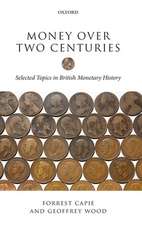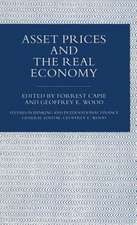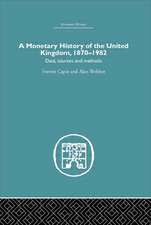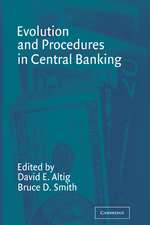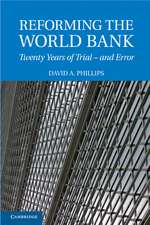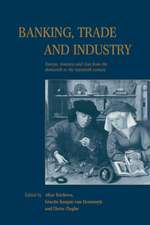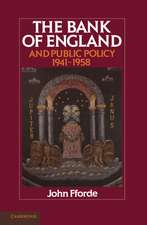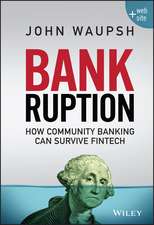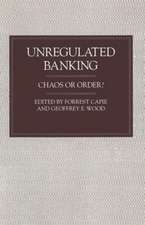The Bank of England: 1950s to 1979: Studies in Macroeconomic History
Autor Forrest Capieen Limba Engleză Paperback – 26 aug 2012
| Toate formatele și edițiile | Preț | Express |
|---|---|---|
| Paperback (1) | 439.26 lei 6-8 săpt. | |
| Cambridge University Press – 26 aug 2012 | 439.26 lei 6-8 săpt. | |
| Hardback (1) | 1111.37 lei 6-8 săpt. | |
| Cambridge University Press – 19 iul 2010 | 1111.37 lei 6-8 săpt. |
Din seria Studies in Macroeconomic History
-
![Teach Your Kids about Countries [Vol 5]: Version Adaptada Al Castellano Actual Por Rafael Antunez y Raul Alonso](https://i4.books-express.ro/bs/9781480268197/teach-your-kids-about-countries-vol-5.jpg) Preț: 61.51 lei
Preț: 61.51 lei -
 Preț: 72.83 lei
Preț: 72.83 lei -
 Preț: 92.61 lei
Preț: 92.61 lei -
 Preț: 40.48 lei
Preț: 40.48 lei -
 Preț: 104.33 lei
Preț: 104.33 lei -
![Teach Your Kids about Countries [Vol13]: Version Adaptada Al Castellano Actual Por Rafael Antunez y Raul Alonso](https://i2.books-express.ro/bs/9781480268272/teach-your-kids-about-countries-vol13.jpg) Preț: 61.51 lei
Preț: 61.51 lei -
 Preț: 46.84 lei
Preț: 46.84 lei -
 Preț: 125.81 lei
Preț: 125.81 lei -
 Preț: 135.03 lei
Preț: 135.03 lei -
 Preț: 131.58 lei
Preț: 131.58 lei -
 Preț: 63.20 lei
Preț: 63.20 lei -
 Preț: 201.10 lei
Preț: 201.10 lei -
 Preț: 95.96 lei
Preț: 95.96 lei -
 Preț: 238.93 lei
Preț: 238.93 lei -
![Teach Your Kids about Countries [Vol 25]: Version Adaptada Al Castellano Actual Por Rafael Antunez y Raul Alonso](https://i0.books-express.ro/bs/9781480268401/teach-your-kids-about-countries-vol-25.jpg) Preț: 61.51 lei
Preț: 61.51 lei -
 Preț: 59.67 lei
Preț: 59.67 lei -
 Preț: 54.03 lei
Preț: 54.03 lei -
 Preț: 55.99 lei
Preț: 55.99 lei -
![Teach Your Kids about Countries [Vol4 ]: Version Adaptada Al Castellano Actual Por Rafael Antunez y Raul Alonso](https://i3.books-express.ro/bs/9781480268180/teach-your-kids-about-countries-vol4.jpg) Preț: 61.51 lei
Preț: 61.51 lei -
 Preț: 88.56 lei
Preț: 88.56 lei -
 Preț: 130.65 lei
Preț: 130.65 lei -
 Preț: 86.92 lei
Preț: 86.92 lei - 20%
 Preț: 45.72 lei
Preț: 45.72 lei -
 Preț: 83.38 lei
Preț: 83.38 lei -
 Preț: 212.46 lei
Preț: 212.46 lei -
 Preț: 56.92 lei
Preț: 56.92 lei - 9%
 Preț: 592.76 lei
Preț: 592.76 lei -
 Preț: 62.62 lei
Preț: 62.62 lei -
 Preț: 74.52 lei
Preț: 74.52 lei -
 Preț: 123.49 lei
Preț: 123.49 lei -
![Teach Your Kids about Countries [Vol 17]: Version Adaptada Al Castellano Actual Por Rafael Antunez y Raul Alonso](https://i2.books-express.ro/bs/9781480268326/teach-your-kids-about-countries-vol-17.jpg) Preț: 61.51 lei
Preț: 61.51 lei -
![Teach Your Kids about Countries [Vol 22]: Version Adaptada Al Castellano Actual Por Rafael Antunez y Raul Alonso](https://i2.books-express.ro/bs/9781480268371/teach-your-kids-about-countries-vol-22.jpg) Preț: 61.51 lei
Preț: 61.51 lei -
![Teach Your Kids about Countries [Vol8]: Version Adaptada Al Castellano Actual Por Rafael Antunez y Raul Alonso](https://i2.books-express.ro/bs/9781480268227/teach-your-kids-about-countries-vol8.jpg) Preț: 61.70 lei
Preț: 61.70 lei -
 Preț: 208.23 lei
Preț: 208.23 lei -
 Preț: 96.04 lei
Preț: 96.04 lei -
 Preț: 96.45 lei
Preț: 96.45 lei - 8%
 Preț: 470.07 lei
Preț: 470.07 lei -
![Teach Your Kids about Countries [Vol2]: Version Adaptada Al Castellano Actual Por Rafael Antunez y Raul Alonso](https://i1.books-express.ro/bs/9781480268166/teach-your-kids-about-countries-vol2.jpg) Preț: 61.51 lei
Preț: 61.51 lei -
 Preț: 69.21 lei
Preț: 69.21 lei -
 Preț: 64.79 lei
Preț: 64.79 lei -
 Preț: 95.31 lei
Preț: 95.31 lei -
 Preț: 51.11 lei
Preț: 51.11 lei -
 Preț: 51.36 lei
Preț: 51.36 lei -
 Preț: 75.99 lei
Preț: 75.99 lei -
 Preț: 78.74 lei
Preț: 78.74 lei -
 Preț: 93.90 lei
Preț: 93.90 lei -
 Preț: 167.96 lei
Preț: 167.96 lei -
 Preț: 53.96 lei
Preț: 53.96 lei - 9%
 Preț: 592.70 lei
Preț: 592.70 lei -
 Preț: 71.19 lei
Preț: 71.19 lei
Preț: 439.26 lei
Nou
Puncte Express: 659
Preț estimativ în valută:
84.09€ • 86.53$ • 70.88£
84.09€ • 86.53$ • 70.88£
Carte tipărită la comandă
Livrare economică 01-15 martie
Preluare comenzi: 021 569.72.76
Specificații
ISBN-13: 9781107621695
ISBN-10: 1107621690
Pagini: 920
Ilustrații: 53 b/w illus. 38 tables
Dimensiuni: 152 x 229 x 58 mm
Greutate: 1.36 kg
Editura: Cambridge University Press
Colecția Cambridge University Press
Seria Studies in Macroeconomic History
Locul publicării:New York, United States
ISBN-10: 1107621690
Pagini: 920
Ilustrații: 53 b/w illus. 38 tables
Dimensiuni: 152 x 229 x 58 mm
Greutate: 1.36 kg
Editura: Cambridge University Press
Colecția Cambridge University Press
Seria Studies in Macroeconomic History
Locul publicării:New York, United States
Cuprins
1. Introduction and overview; 2. The Bank in the 1950s; 3. The monetary setting and the Bank; 4. The Bank's external responsibilities to 1964; 5. From crisis to 'crucifixion'; 6. Domestic monetary policy after Radcliffe; 7. Other activities and performance; 8. Sterling from devaluation to Smithsonian; 9. The road to competition and credit control; 10. Competition and credit control; 11. The secondary banking crisis; 12. Banking supervision; 13. Monetary targets and monetary control; 14. The Bank and sterling in the 1970s; 15. The Bank's freedom to operate; 16. Epilogue.
Recenzii
Reviews of the hardback: 'A treasure trove for economic historians. Capie has done a fine job and is particularly strong on what one might call the science of inter-institutional dynamics.' Howard Davies, The Financial Times
'Forrest Capie … has not only written a meticulously researched, scholarly account of the history of 'the Old Lady of Threadneedle Street' from Attlee to Thatcher, but he has produced a cogent analysis of how the bank managed the exchange rate and administered monetary policies before the banking instability of the 1970s saw its powers curtailed. A potentially dry subject is enlivened by Mr Capie's insights on the personal conflicts and compromises among the bank's leaders as they grappled with the challenges of the day.' The Economist's Intelligence Unit
'Who would have thought that a … chronicle of central banking could be so engaging? This elegant and slyly written book contains probably the most revealing record of a central bank's struggles in the modern era.' Benjamin Schwarz, The Atlantic Monthly
'This thorough and interesting account is an indispensable reference for anyone who would understand the Bank of England, or more generally the theories, institutions, and politics of British economic policies before the changes that followed 1979.' John Wood, EH.net
'Forrest Capie has written an invaluable work of impeccable historical scholarship. Not only do we now have a scrupulously researched and beautifully written history of the Bank of England from Attlee to Thatcher, a work of reference that all students of financial history will come to revere, but we also gain some fascinating insights into the way an earlier generation grappled with the problems of financial regulation, inflation, asset bubbles, and banking crises.' Niall Ferguson, Laurence A. Tisch Professor of History and William Ziegler Professor, Harvard University
'Forrest Capie brings the sure hand of an economist to the task of describing the intellectual confusion that besieged the Bank of England as it tried to establish its role as a central bank responsible for easing the British economy through the difficult adjustments required between 1950 and 1979. But he also displays his talent as an historian in depicting the drama of the personal conflicts, compromises, and eventual triumphs that occurred within the leadership of the Bank as they confronted first the constraints of fixed exchange rates with capital controls while dealing with the demands of the Treasury, and then the collapse of both fixed exchange rates and capital controls in the 1970s. A compelling saga of the world's oldest central bank as it tested various paths leading toward an effective role in financial globalization.' Larry Neal, University of Illinois, Urbana-Champaign
'Outstanding scholarship … well written … and showing a fine independence of judgment.' Lord Griffiths of Fforestfach
'Forrest Capie provides what will certainly be the definitive account of the Old Lady of Threadneedle Street's varying fortunes though the second third of the 20th century. The history is brought to life by its numerous portraits of the principal actors and its clear-eyed judgments on their work. A magnificent achievement.' Robert Pringle, Founder and Chairman, Central Banking Publications
'A masterful, well-contextualised account of the Bank at the summit of its traditional responsibilities and the peak of its personnel. Authoritative and meticulous yet accessible and colourful, it is an indispensable addition to postwar financial and economic history. Along with forerunner volumes by Clapham, Sayers and Fforde, Capie's study is destined to become a classic.' Richard Roberts, King's College London
'Forrest Capie … has not only written a meticulously researched, scholarly account of the history of 'the Old Lady of Threadneedle Street' from Attlee to Thatcher, but he has produced a cogent analysis of how the bank managed the exchange rate and administered monetary policies before the banking instability of the 1970s saw its powers curtailed. A potentially dry subject is enlivened by Mr Capie's insights on the personal conflicts and compromises among the bank's leaders as they grappled with the challenges of the day.' The Economist's Intelligence Unit
'Who would have thought that a … chronicle of central banking could be so engaging? This elegant and slyly written book contains probably the most revealing record of a central bank's struggles in the modern era.' Benjamin Schwarz, The Atlantic Monthly
'This thorough and interesting account is an indispensable reference for anyone who would understand the Bank of England, or more generally the theories, institutions, and politics of British economic policies before the changes that followed 1979.' John Wood, EH.net
'Forrest Capie has written an invaluable work of impeccable historical scholarship. Not only do we now have a scrupulously researched and beautifully written history of the Bank of England from Attlee to Thatcher, a work of reference that all students of financial history will come to revere, but we also gain some fascinating insights into the way an earlier generation grappled with the problems of financial regulation, inflation, asset bubbles, and banking crises.' Niall Ferguson, Laurence A. Tisch Professor of History and William Ziegler Professor, Harvard University
'Forrest Capie brings the sure hand of an economist to the task of describing the intellectual confusion that besieged the Bank of England as it tried to establish its role as a central bank responsible for easing the British economy through the difficult adjustments required between 1950 and 1979. But he also displays his talent as an historian in depicting the drama of the personal conflicts, compromises, and eventual triumphs that occurred within the leadership of the Bank as they confronted first the constraints of fixed exchange rates with capital controls while dealing with the demands of the Treasury, and then the collapse of both fixed exchange rates and capital controls in the 1970s. A compelling saga of the world's oldest central bank as it tested various paths leading toward an effective role in financial globalization.' Larry Neal, University of Illinois, Urbana-Champaign
'Outstanding scholarship … well written … and showing a fine independence of judgment.' Lord Griffiths of Fforestfach
'Forrest Capie provides what will certainly be the definitive account of the Old Lady of Threadneedle Street's varying fortunes though the second third of the 20th century. The history is brought to life by its numerous portraits of the principal actors and its clear-eyed judgments on their work. A magnificent achievement.' Robert Pringle, Founder and Chairman, Central Banking Publications
'A masterful, well-contextualised account of the Bank at the summit of its traditional responsibilities and the peak of its personnel. Authoritative and meticulous yet accessible and colourful, it is an indispensable addition to postwar financial and economic history. Along with forerunner volumes by Clapham, Sayers and Fforde, Capie's study is destined to become a classic.' Richard Roberts, King's College London
Notă biografică
Descriere
This history of the Bank of England takes its story from the 1950s to the end of the 1970s.

